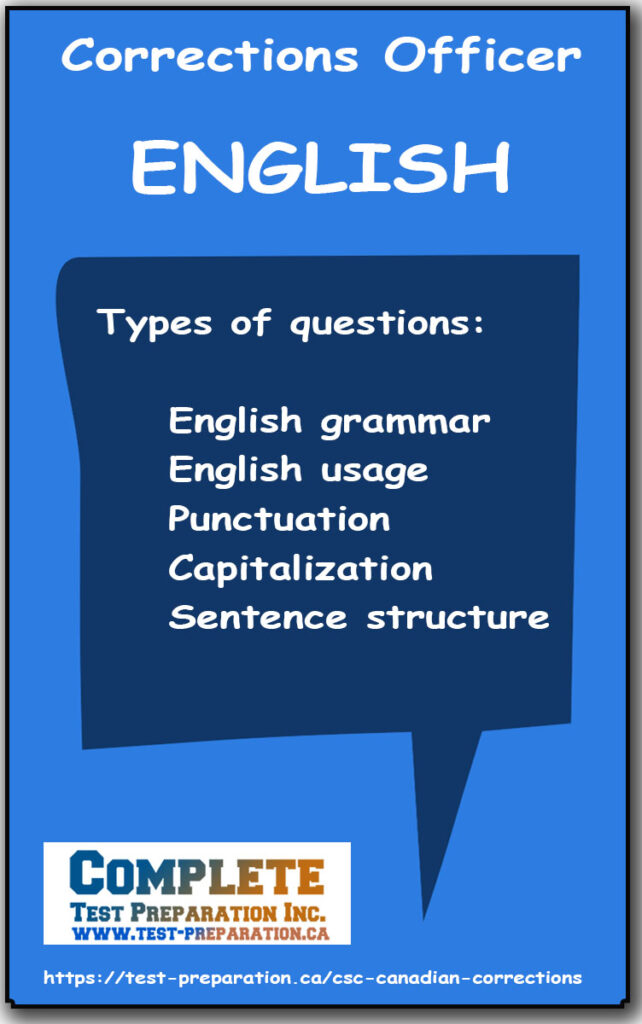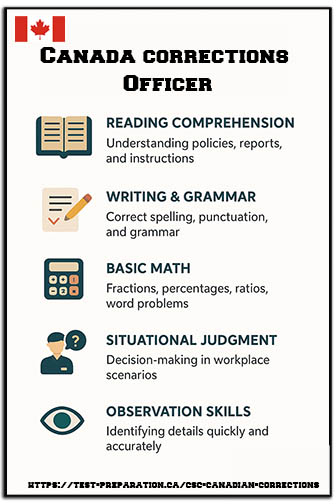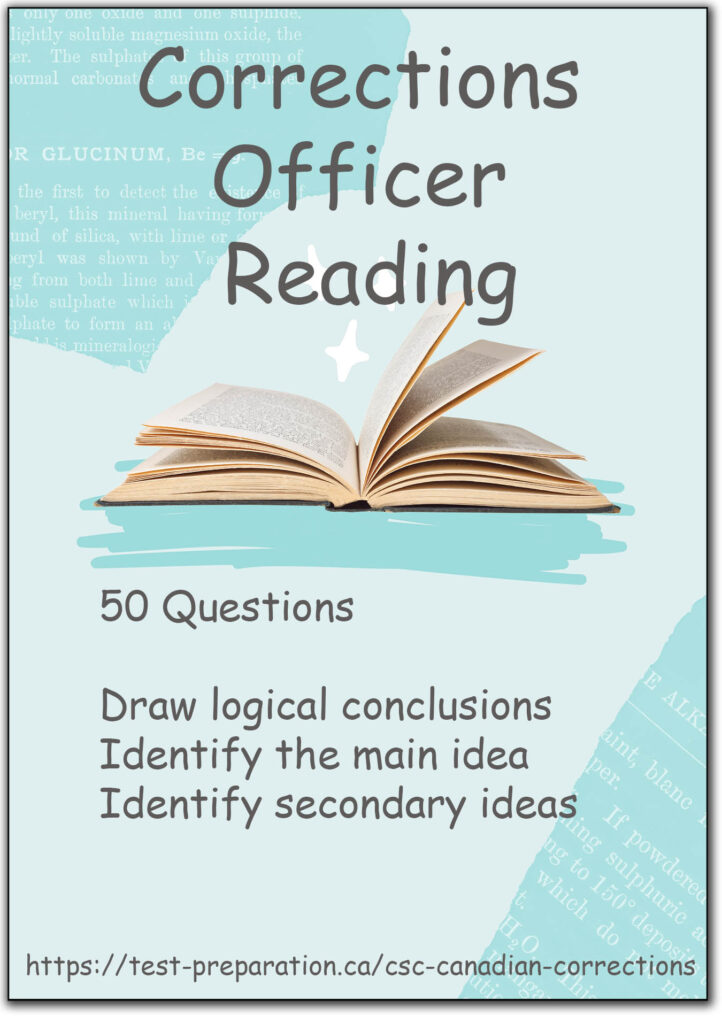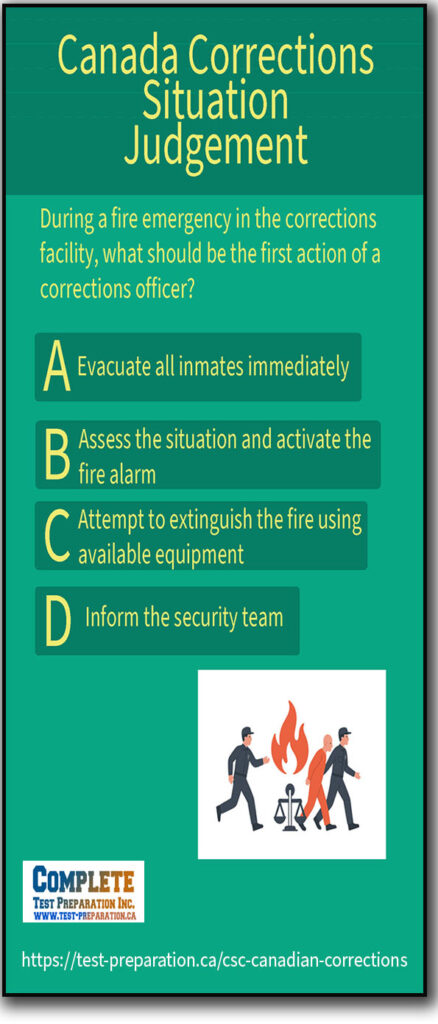Corrections Canada Officer – practice questions, tutorials and test tips
- Posted by Brian Stocker
- Date February 11, 2021
- Comments 9 comments
How to become a correctional officer in Canada
Overview
CSC has approximately 7,800 employees, and approximately 15,000 offenders in federal custody. Correctional officers monitor and supervise inmates in penitentiaries.
The Canadian Corrections Officer test is a requirement to work for at Correctional Service of Canada (CSC). This is a difficulty process, and most applicants fail the application process.
Corrections Officers are employed by Canadian Corrections Service (CSC) and charged with overseeing prisoners in prisons and correctional facilities and individuals awaiting trial after the arrest. Some may be employed in psychiatric hospitals as well as substance abuse facilities.

Eligibility
Applicants must be:
- 18 years
- A Canadian Citizen
- Hold a High school diploma or equivalent
- Valid First Aid and cardiopulmonary resuscitation (CPR) ‘Level C’ with automated external defibrillator (AED) certificate from a qualified provider approved by any province/territory in Canada
- Complete a Medical exam
- Complete a Psychological exam
- Hold an unrestricted driver’s license
- Take the CSC Correctional Training Program (CTP)
Valuable Qualifications
These are not required but valuable if you have them. Otherwise you will gain this type of training on the job.
- Experience with ethnocultural or Indigenous peoples, communities or organizations.
- Ability to communicate (orally and in writing) in a language other than English or French.
- Ability to work shifts, weekends and holidays, as well as overtime.

Corrections Officer Physical Abilities Test (COPAT)
The COPAT physical ability test includes :
- Run 50 meters
- Mobility, Agility & Speed Run
- Stair Run
- Push Station
- Pull Station
- Squat, Thrust and Stand
Weight Carry
CSC Psychological Assessment
The psychological assessments will test you for “good ethical character, trustworthiness, integrity, judgement and interpersonal skills.” The psychological test makes sure that you have a minimum level of stress tolerance and emotional stability to work in a position of trust and handle difficult situations.
What’s on the Test
The CSC Corrections Officer Test has two sections, a Corrections Situational Judgement, and the Written Communication Proficiency Test (WCPT-351)
The WCPT test gives a series of short passages followed by multiple choice questions with suggested corrections. Questions include:
- Grammar
- Punctuation
- Re-Ordering paragraphs and sentences
- Main Idea
Also Reading Comprehension
The Corrections Canada situational judgement questions are designed to assess your judgment and problem-solving ability by presenting work-related scenarios in the Correctional Service of Canada (CSC).
The scenarios cover the following themes:
- Response to fire, environmental hazards and medical emergencies
- Security of the institution and the public
- Enhance offender accountability
- Security of inmates, including during transport
Canada Corrections Course
Canada Corrections Practice
100s of practice questions, plus tutorials and Corrections Situational Judgement – Start Practicing in Minutes – Be Test-Ready Tomorrow!”
Online Course (with free quiz) — PDF Download Version — Paperback (Amazon)
Corrections Practice Questions
As someone who has prepared for many many tests, I can’t stress enough how valuable practice questions are. When I started studying, I felt overwhelmed by the breadth of content covered in the test. But working through practice questions was a game-changer for me.
Here’s why I recommend these practice questions:
Get used to the Format: The OTEE has a specific format, and the more you know about it, the better your score!
Identify your Weak Areas: This is the key to test prep. When I first started practicing, I quickly realized which areas I needed to focus on more. Whether it was math, reading comprehension, or language skills, working through practice questions helped me pinpoint my weaknesses so that I could spend more time improving in those areas.
Building up your Confidence: The more questions I answered, the more confident I became. Practice questions gave me the confidence that I could handle whatever the test threw at me.
Time Management on a Test: One of the biggest challenges I found was managing my time. Practice questions under timed conditions, boosted my confidence. How to manage your time on a test
Reviewing Mistakes: Every time I got a question wrong, I looked at the explanation and trued to understand my mistake.
Reading Comprehension
Corrections professionals regularly read legal documents, regulations, policies, and reports. Reading comprehension skills are necessary to comprehend these complex documents accurately.
Corrections professionals frequently work with reports and case files related to inmates, incidents, and interventions. These documents often contain detailed information that needs to be understood and analyzed. Reading comprehension skills enable corrections professionals to extract relevant information, identify critical details, and draw logical conclusions.
Reading comprehension is closely linked to effective communication skills. Canada Corrections professionals need to read and comprehend written communications, such as emails, memos, and reports, from colleagues, supervisors, and other stakeholders. Understanding written material accurately, professionals can then respond appropriately, follow instructions, and convey information effectively.
Below is a list of the types of questions that may appear on the WCT.
- Find facts and information in a passage
- Identify the main idea
- Identify secondary ideas
English
Grammar and punctuation clarify meaning and avoid ambiguity. Corrections professionals follow grammatical rules and use punctuation correctly to ensure their responses are clear and unambiguous. Clear communication in a corrections setting where misinterpretations that can have serious consequences.
Corrections professionals need to communicate information, instructions, and reports clearly and concisely. A good knowledge of English grammar allows professions to express themselves accurately, follow established writing conventions, and convey messages effectively to others.
Misinterpretation and miscommunication can have serious consequences in a corrections workplace. Incorrect grammar and punctuation can lead to misunderstandings and confusion.
Types of questions that may appear on the test:
- English grammar
- English usage
- Punctuation
- Capitalization
- Sentence structure – run-on sentences, fragments etc.
English Practice
Correcting Sentences and Passages (WCT format)
Additional Practice

Canada Corrections Practice
100s of practice questions, plus tutorials and Corrections Situational Judgement – Start Practicing in Minutes – Be Test-Ready Tomorrow!”
Online Course (with free quiz) — PDF Download Version — Paperback (Amazon)
Corrections Situational Judgement
The Corrections Canada situational judgement questions are designed to assess your judgment and problem-solving ability by presenting work-related scenarios in the Correctional Service of Canada (CSC).
The scenarios cover the following themes:
- Response to fire, environmental hazards and medical emergencies
- Security of the institution and the public
- Enhance offender accountability
- Security of inmates, including during transport
Correcitons Situational Judgement Practice
Corrections Situational Judgement
Corrections Situational Judgement Online Practice
Situational Judgement Practice (Extra practice – Management related)
Canada Corrections Practice
100s of practice questions, plus tutorials and Corrections Situational Judgement – Start Practicing in Minutes – Be Test-Ready Tomorrow!”
Online Course (with free quiz) — PDF Download Version — Paperback (Amazon)
Date Published: Thursday, February 11th, 2021
Date Modified: Thursday, October 9th, 2025
Got a Question? Email me anytime - Brian@test-preparation.ca
You may also like
Police Problem Solving for SSPO and OACP Test
Police Problem Solving: Rule Application (Deductive Logic) This section of the SSPO (Sigma Survey for Police Officers) and OACP certificate process measures your ability to apply a general rule or a policy to a specific real-world situation or scenario. This …
Toolbox Math – Basic Math for Trades
Basic Math Practice Questions for Canadian Trades Trades Entrance Canada Trades Alberta Trades Skilled Trades Readiness
CELPIP Writing Prompts
The CELPIP writing evaluates your ability to communicate effectively in written English different tasks. Here are some sample CELPIP Writing prompts for writing an exmail. You are given a prompt and a scenario. Your email may be formal or informal, …




9 Comments
do you have more situational judgement? I really need help
Hello,
I am also looking for SJT questions. If you have any material, please share with me.
thank you
Yes! Some practice questions here https://test-preparation.ca/situational-judgement-practice-questions/
and https://courses.test-preparation.ca/course/sjt-318
Could you add more situational judgment? I find them the hardest part and need a lot of practice.
Can I get a video walk throughs for more sections
Thanks for supporting such a difficult test. Really boosted my confidence.
When are you going to update this? I want the most recent and up dated
can I get timed mock tests so I can practice under pressure
YES – Corrections online course here – with timed tests – https://courses.test-preparation.ca/course/canada-corrections